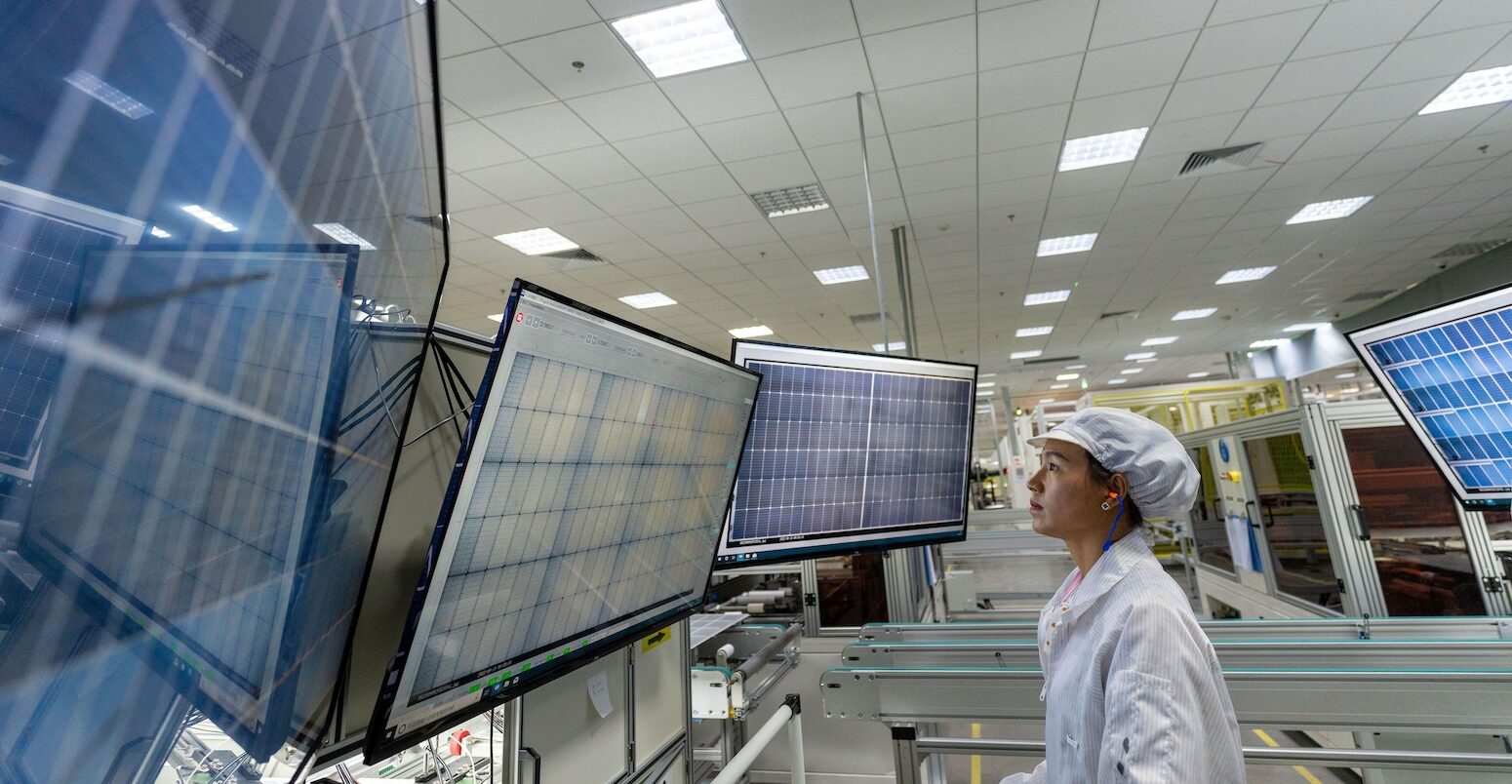
Guest post: Solar plus batteries ‘cheaper than new coal’ for meeting China’s rising demand
Multiple Authors
05.09.24Multiple Authors
09.05.2024 | 11:51amChina’s climate and energy policies present something of a paradox: while expanding clean energy at breakneck speed, China has also been building new coal power plants.
In 2023 alone, 70 gigawatts (GW) of new coal-fired power capacity was constructed in China, up four-fold since 2019 and accounts for 95% of the world’s new coal power construction activity in that year.
This surge of coal capacity raises concerns about China’s carbon dioxide (CO2) emissions and climate goals, as well as the risk of stranded assets down the line.
Coal is being pitched by the Chinese government as the means to guarantee energy security and to meet rapidly-rising peaks in electricity demand, because solar and wind output is variable.
At the same time, China’s electricity sector is seeing major changes in terms of costs, demand patterns, regulation and market operation. Our new study indicates that the traditional economic calculus used to justify new coal capacity may be outdated.
Using a simple, analytical metric for evaluating the most economic way to meet peak demand, we show that a combination of solar plus battery storage may be a more cost-effective option than new coal.
- How has China’s electricity landscape changed?
- How does an alternative metric evaluate the cost?
- What is the most economic way to meet peak demand?
- How can our solution help China with its climate goals?
How has China’s electricity landscape changed?
Over the past decade, the costs of renewables and battery storage have decreased substantially, peak-time residential and commercial demand has surged, and wholesale electricity markets have gained greater traction.
Meanwhile, China also announced “dual carbon” goals of peaking CO2 emissions before 2030 and reaching carbon neutrality by 2060. Given these transformations, building more unabated coal power conflicts with China’s long-term climate commitments and may no longer be the most cost-effective option to meet demand growth. It also diverts much-needed capital from the transition toward a clean power system.
How does an alternative metric evaluate the cost?
Our study introduces an alternative metric for calculating the cost-optimal investments needed to meet rising peak electricity demand.
This metric, “net capacity cost”, is the annualised fixed costs of investment in infrastructure needed to meet peak demand minus electricity market revenues earned by this infrastructure, or its “system value”. In this metric, a negative figure means that instead of a cost, such investments would turn a profit.
To explore this metric in a Chinese context, we use a simple example of a 1,500 megawatt (MW) increase in peak electricity demand and a 6,570 gigawatt hour (GWh) rise in demand across a full year, in a hypothetical province.
We then outline five strategies (cases) for meeting these peak and annual energy demands, ranging from heavy reliance on coal through to a combination of solar and battery storage.
In the different cases, resources are sized based on how much they can reliably contribute to peak supply needs and annual energy needs:
- Case 1: New coal power capacity meets all of the growth in both peak and annual energy demand.
- Case 2: Solar meets 70% and coal meets 30% of annual energy demand growth; solar contributes 525MW to peak supply needs – based on a “capacity credit” to discount solar capacity because it may not generate during peak periods – while coal provides the remaining 975MW.
- Case 3: Solar meets all annual energy demand growth; solar and coal both contribute 750MW to peak supply needs, again discounting solar with a capacity credit.
- Case 4: Solar meets all annual energy demand growth; solar and batteries both contribute 750MW to peak supply needs; batteries provide frequency regulation reserves (backup power for managing minute-to-minute differences between supply and demand).
- Case 5: Solar meets all annual energy demand growth; solar and batteries both contribute 750MW to peak supply needs; batteries provide energy arbitrage (charge when prices or costs are low, discharge when they are high).
For each case, shown in the table below, we calculated the annual net cost for both the individual resource (coal, battery or solar), as well as for the system as a whole for securing one kilowatt (kW) of power generation capacity in yuan per year.
The resource net capacity cost in the top half of the table is the net cost of that resource (i.e., the annualised fixed cost minus annual revenue that resource earns from providing energy and ancillary services, such as frequency regulation). Positive numbers show a net cost to the grid operator in adding or procuring that resource.
The total system net capacity cost, in the second half of the table, is the net cost of meeting peak demand growth with the combination of resources in each case.
The weighting that we used to calculate system net costs is based on the ratio of installed capacity and peak demand growth.
Cost of different combinations of energy sources to meet electricity demand
| Case 1 | Case 2 | Case 3 | Case 4 | Case 5 | |
|---|---|---|---|---|---|
| Resource net capacity cost (yuan per kW per year, per kW of installed capacity) | |||||
| Coal | 424 | 424 | 512 | ||
| Battery | 248 | 781 | |||
| Solar | -128 | -128 | -128 | -128 | |
| System net capacity cost (yuan per kW per year, per kW of capacity used to meet peak demand, after capacity credit) | |||||
| Coal | 471 | 306 | 236 | ||
| Battery | 138 | 434 | |||
| Solar | -223 | -319 | -319 | -319 | |
| Total | 471 | 83 | -83 | -181 | 115 |
In order to stress-test this simple analysis, we looked at sensitivities of a variety of prices for different sources.
With solar prices in China already very low, our sensitivity analysis focused on the price of coal, batteries and other inputs to the analysis.
What is the most economic way to meet peak demand?
Our results indicate that when battery storage provides frequency regulation reserves (case 4), a combination of solar and storage is the most cost-effective option for meeting peak demand growth.
This combination could cost grid operators -181 yuan (about -$25 or -£20) for each kilowatt of capacity added.
In contrast, building new coal capacity to meet peak demand growth (case 1) is the most expensive option, with a net capacity cost of 471 yuan (about $65 or £52) for securing one kilowatt of capacity per year.
Case 3, in which large coal power plants are only used for backup power (little to no generation), may not be politically feasible in China, at least in the near term.
The other two cases (case 2 and case 5) are more comparable, but given that battery prices have fallen by more than 30% since this analysis was performed – to about 1 yuan (about $0.14 or £0.11) per watt-hour (Wh) of capacity – the batteries in case 5 are likely more economically attractive than the coal in case 2.
How can our solution help China with its climate goals?
To navigate this changing landscape, our analysis suggests that a near-term strategy for meeting China’s rising energy demand while also working towards its climate goals involves enabling battery storage participation in electricity markets.
Currently, the Chinese government allows “new energy storage”, including batteries, to participate in the electricity market. However, the detailed regulations are ambiguous and battery participation could be made simpler.
For example, battery storage is not allowed to provide “operational reserves” referring to capacity that is held in reserve to manage unexpected differences between supply and demand. Making battery storage eligible for this would enhance its business case.
Allowing greater market participation for battery storage would foster continued innovation and cost reductions in battery storage systems, while offering valuable operational experience for system operators.
Such a strategy would be consistent with market outcomes and reflects recent electricity market experience in the US and Europe.
It would also help to resolve near-term capacity and energy needs, as batteries and solar generation can typically be built more quickly than coal-fired power plants.
Moreover, it would help to alleviate future conflicts between new coal generation and renewable energy. New coal generation built mainly as a backup for renewable generation will either rarely operate or encroach on operating hours and net income for other existing coal generators, creating new stranded asset risks.
Continued electricity market reforms would also facilitate more efficient investments in renewable generation and electricity storage.
Allowing wholesale electricity prices to be set by the market and allowing renewable generation and electricity storage to participate in wholesale markets can enhance their revenue and profits.
Furthermore, the reforms would encourage the efficient utilisation of electricity storage, which is our key finding. Electricity storage can provide a variety of functions for the electricity system; wholesale prices can help to guide the operation of storage toward those functions that have the highest value at the lowest cost.
The recent directive from China’s national energy administration (NEA) that integrates new types of storage facilities (non-pumped hydro) into grid dispatch operation is a step towards the reforms we outline.
Appropriate compensation mechanisms, such as capacity payments in some provinces, for all the services that such storage facilities provide, may need to be further defined to promote the sustainable development and integration of these storage facilities into the grid.
Finally, additional supply alone is unlikely to be the lowest-cost way to meet growth in electricity demand in China. Improving end-use efficiency and “demand response” can also help to reduce the overall cost of supplying electricity.
As China continues its electricity market reforms, regional market designs linking multiple provinces, as well as and regional approaches to resource adequacy that encourage resource sharing among provinces, could also help to meet China’s rising electricity use and peak demand in the most cost-effective and lowest-carbon way possible.
-
Guest post: Solar plus batteries ‘cheaper than new coal’ for meeting China’s rising demand



